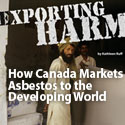Health Canada is not publishing the report on the risk of cancer associated with chrysotile asbestos complied by an expert panel it assembled in 2007. The report has been made available through an Access to Information Act request from the media. Experts involved in the panel have raised some concerns in this regard, as the usual practice is for Health Canada to publish any studies that it funds on its website. The controversy over Canada’s exporting of asbestos to developing countries has been ongoing, and this recent report illustrates the divide between scientific opinion and the government of Canada’s position on asbestos. One expert on the panel stated that he “would be reluctant to work with Health Canada again because he feels the government “violated” an understanding that the work would be published in a timely fashion on a government website.” The report concludes that there is a strong relationship of exposure with lung cancer, a problematic finding for Canada’s asbestos industry.
Read the full article below.
Motive questioned in failure to disclose asbestos study
Government trying to protect Quebec industry, scientist alleges
MARTIN MITTELSTAEDT
From Wednesday’s Globe and Mail
April 22, 2009 at 4:44 AM EDT
ENVIRONMENT REPORTER
***
A British expert who oversaw a report on the dangers of the chrysotile variety of asbestos says he believes Ottawa tried to suppress his work to protect the Quebec industry that mines the cancer-causing mineral.
“I can only speculate, and my speculation is that there were interests in continuing Canadian production of chrysotile and they saw the report as a threat,” Trevor Ogden, editor-in-chief of the Annals of Occupational Hygiene and a former top adviser to the British government on asbestos hazards, said in an interview.
Dr. Ogden headed an expert panel that Health Canada assembled in late 2007 to study the cancer risk of chrysotile. The report has been ready since March, 2008, but has been available only since last week after Access to Information Act requests from the media, including The Globe and Mail.
Health Canada isn’t publishing the report on its website, the usual practice for scientific studies that it funds, but says anyone who asks for a copy will be given one.
Although the link between asbestos and cancer is accepted internationally, the saga of the report indicates just how sensitive the issue is within the federal government.
Canada and other developed countries use little asbestos, and many nations ban it because of the health and liability risk. Most of Quebec’s production is exported to the developing world for use as an inexpensive additive to strengthen cement building products.
Ottawa has spent nearly $20-million since 1984 promoting the mineral abroad.
Health Canada said it delayed releasing the report because of the need to study it. “Health Canada took the time necessary to carefully review the findings of the report, and to consult with other federal and provincial partners,” it said in a statement to The Globe.
The introduction to the report, written by Dr. Ogden, concludes that chrysotile shows “a strong relationship of exposure with lung cancer, but a much less certain relationship with mesothelioma,” a cancer in the lining of the chest wall.
The report also concludes that chrysotile generally contains trace amounts of a more harmful variety of asbestos known as tremolite.
As well, the panel noted but couldn’t explain why the results of two studies suggest that it is far more of a health hazard for people to work with asbestos than to mine it.
The studies showed that lung cancer risk in South Carolina textile workers who use asbestos was about 70 times greater than that of Quebec’s miners, according to the report. Asbestos causes cancer when its fibres are inhaled.
In an interview, Leslie Stayner, an epidemiology professor at the University of Illinois who was on Health Canada’s asbestos panel, said researchers do not know why the textile workers were at greater risk. He said one theory is that the longer asbestos fibres used to make textiles are more deadly.
Dr. Stayner says he would be reluctant to work with Health Canada again because he feels the government “violated” an understanding that the work would be published in a timely fashion on a government website.
Health Canada said in its statement that it “sought the advice of leading international scientists on the risks posed by chrysotile asbestos so that it could better understand the scientific debate. No other country has encouraged such a debate amongst scientists with widely varying opinions.”
Health Canada isn’t alone in having trouble handling the issue of asbestos.
Late last month, Liberal Leader Michael Ignatieff responded to a questioner at a town hall in Victoria about Canada’s asbestos exports by saying the sales “of this dangerous product overseas has got to stop.”
The remarks were recorded by the Tyee, the British Columbia-based online magazine.
“I’m probably walking right off the cliff into some unexpected public policy bog of which I’m unaware, but if asbestos is bad for parliamentarians in the Parliament of Canada, it just has to be bad for everybody else,” he said.
But when he was later asked about the remark by reporters, he dropped the call for an end to exports.
Copyright (c) The Globe and Mail



Thu, Apr 23, 2009
Misc.